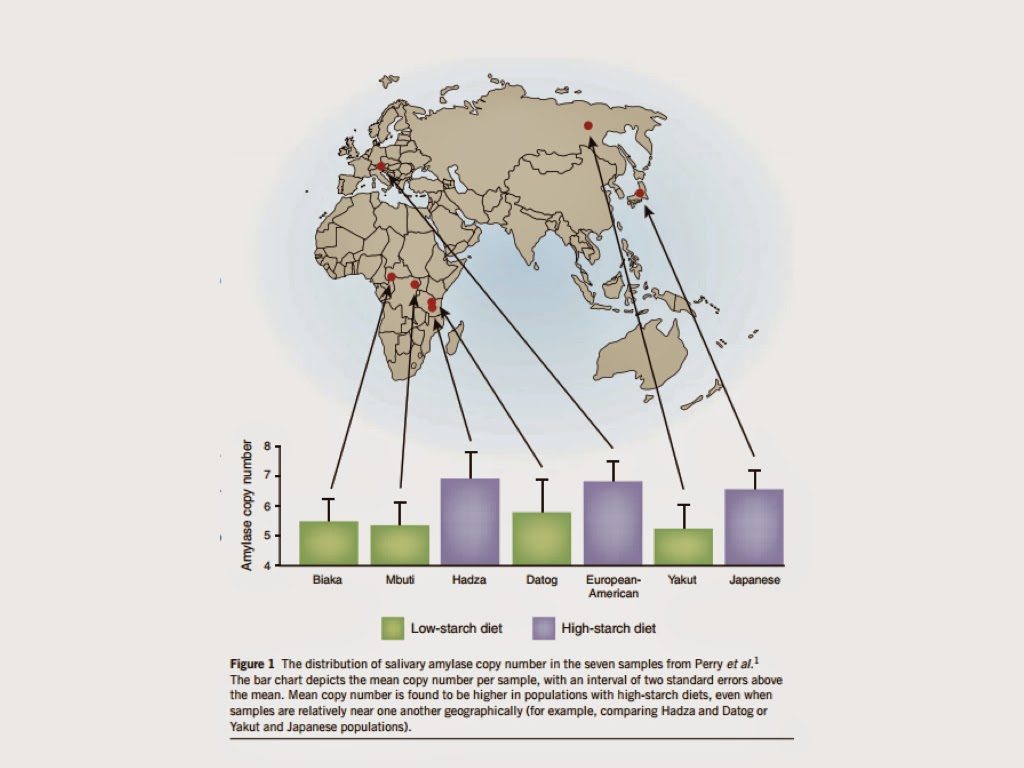
Some people seem to tolerate eating a lot of starchy carbohydrates, while others swear a low carb diet changed their life. The AMY1 gene that codes for salivary amylase might explain why.
Before I knew anything about the effect of diet on my health and hunger, I did notice that an hour or 2 after eating refined starch foods I suffered low blood sugar and was ravenously hungry.
Back in the day (1995) as I’ve written about previously, I discovered the zone diet, it was literally life changing for me.
Through following this eating plan I discovered that refined carbohydrates, particularly those from grains and sugars played havoc with my blood sugar regulation. The Zone diet reduces carbohydrates, for me it was down to around 70 – 100 grams a day, divided to around 20 – 30 grams per meal. Vegetable and low glycemic index (GI) carbohydrates are encouraged over refined grains and high GI carbs.
I’ve followed this principal for 20 years now, and found limiting carbohydrates, and adding protein to each meal (about 20 grams or so net protein, or a small palm size) is critical for both my well-being and appetite regulation. I’ve since found that 50 to 100 grams of carbs per day works well for me, and carbohydrate quality is important. This works out to 1 to 2 grams per kg body weight per day. Note, I don’t eat solely animal protein, I often use pea protein isolate, or sacha inchi powder. I rotate meat, organ meats, seafood and eggs in other meals
I’ve often wondered why I seem to be so sensitive to carbohydrates, while others don’t suffer the dysregulated blood sugars and reactive hypoglycemia and consequent carbohydrate cravings that I do.
The answer may be in my genes. I recently had a gene test to find out how many copies of the AMY1 gene I have, this a gene that codes for salivary amylase.
What is Salivary Amylase?
The suffix or ending -ase when referring to a word related to biology tells us that this means an enzyme. The first part of the word shows us what the enzyme acts on.
Amyl-ase. Amyl refers to amylum or starch. A starch is comprised of a large number of glucose units linked together with a particular bond called a glycosidic bond.
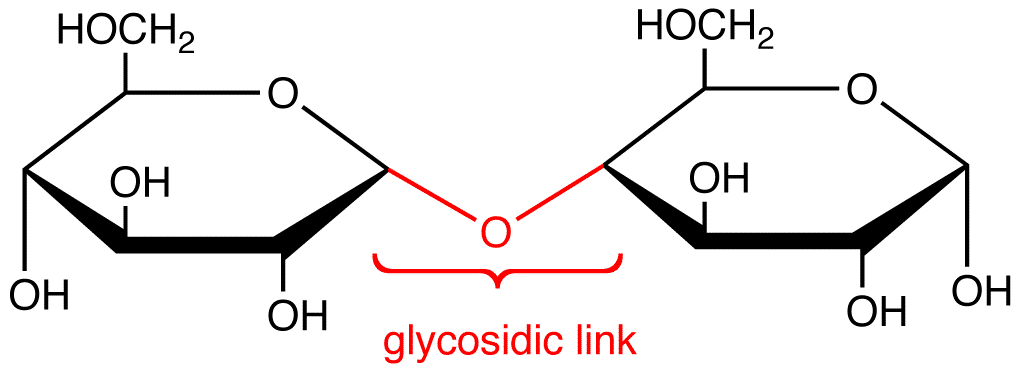
The amylase breaks this bond so that the starch is converted into glucose molecules.
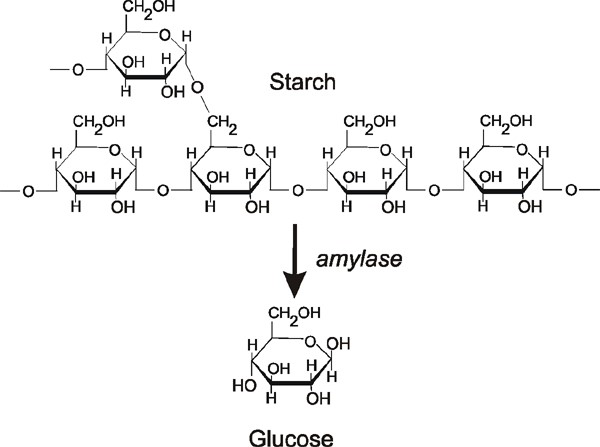
You can think of amylase as being like scissors (source )
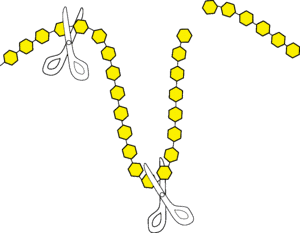
Getting back to the AMY1 gene
The AMY1 gene is a gene that is linked with how much amylase you have in your saliva.
What does copy number mean?
A gene is a segment of information on a chromosome. In the case of AMY1 copy numbers, some people have many repeats of this gene and some only one. This post in Wikipedia explains copy numbers
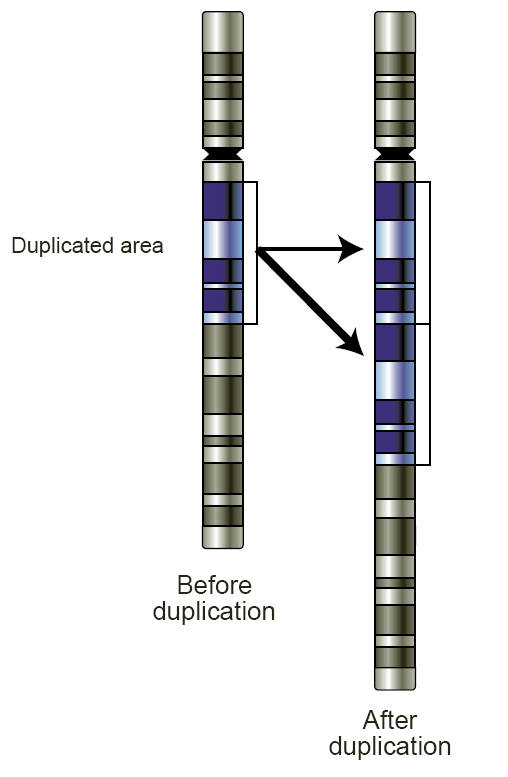
As the AMY1 gene codes for (i.e. gives instructions to make) salivary amylase, the more copy numbers you have the more salivary amylase you make. Copy numbers have been counted from 1 copy up to 20, more typically from 2 to 16. On average humans have 6 copy numbers.
The importance of AMY1 copy numbers
Your copy number affects the amount and activity of amylase in your saliva, this in turn is related to how well a person metabolises and tolerates dietary starch.
People with low copy numbers – between 1 and 4 produce low levels of amylase, and the activity of amylase is low.
Only 10% of the population measure 9 or more copy numbers, these individuals produce more amylase and it has high activity. These people are better able to metabolise and likely suit a higher starch diet.
Research on AMY1 copy numbers
Increased copy numbers appear to be an adaptive response to a starch rich diet in humans. The longer a population is exposed to a diet higher in starch the more copy numbers people in those populations are likely to have (Perry et al, 2007)
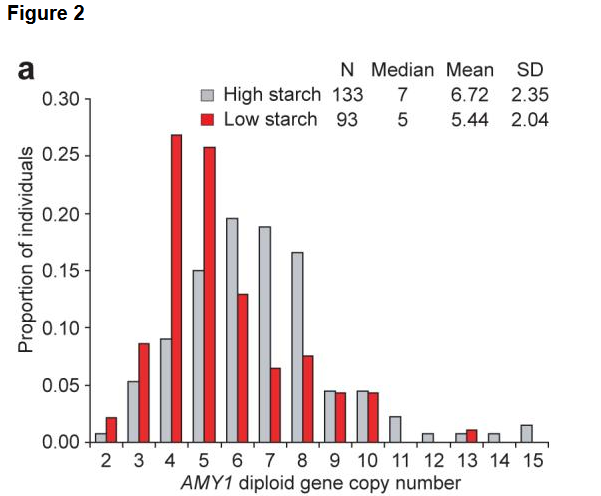
Low copy numbers of the salivary amylase gene predisposes to obesity
Falchi and co tested 6,200 people and found there was a positive correlation between both body mass index (BMI) and fat mass, and low AMY1 copy numbers. They found an 8 fold difference in the risk of obesity between people with a copy number of less than 4 compared to a copy number of greater than 9.
However a more recent study by Usher designed to replicate this result using another method to measure copy numbers, failed to reproduce this relationship (Usher, 2105 )
Other studies have also found relationships between AMY1 copy numbers and obesity:
A Mexican study measuring copy numbers in children found all children with copy numbers greater than 10 were normal weight. The authors think that high copy numbers of AMY1 protect against the obesogenic effect of a high starch diet (Mejía-Benítez et al, 2015)
A study in Finland showed that low copy numbers of AMY1 was associated with early-onset female obesity (Viljakainen, 2015)
How does the AMY1 copy number affect how starch is digested?
When starch enters your mouth – the amylase starts the process of breaking it down into glucose. If there is more amylase then more starch is converted to glucose in the mouth. High salivary amylase is associated with a rapid insulin response, this results in insulin acting sooner on the glucose as it enters the blood stream, as a result glucose does not go as high as those with lower copy numbers who have a more delayed release of insulin.
Low AMY1 copy numbers are associated with insulin resistance in a study of asymptomatic Korean men (Choi, 2015 ) .
The following study shows the difference in glycemic responses to starch ingestion, those with high copy numbers had significantly lower post prandial (post meal) blood glucose concentrations at 45, 60 and 90 minutes compared to those with low copy numbers (Mandel 2012 ).
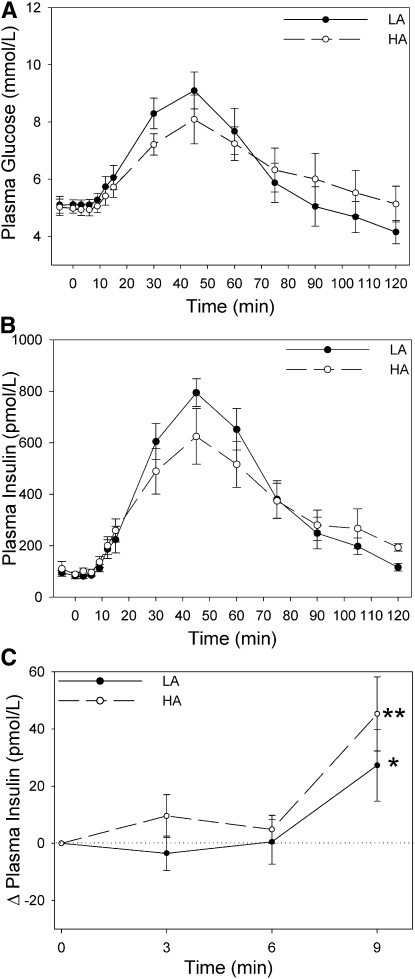
The graphs (B and C) show the insulin response also differs. In (C) you notice that the high amylase (HA) group starts to release insulin within minutes of consuming starch, it is stimulated by starch in the mouth, whereas the LA group it is a more delayed response. In (B) insulin then increases far more after 20 minutes in the LA group, this probably leads to the steep reduction and fall below baseline of blood glucose seen.
These studies suggest that people with a higher salivary amylase have a better glycemic tolerance to dietary starch than those with low salivary amylase. They also have an overall lower blood insulin. Neither high blood glucose or insulin are desirable. They may be at greater risk for insulin resistance and diabetes if they eat a diet chronically high in starch.
How do you get your copy numbers measured?
I got my AMY 1 tested through FitGenes in Australia. I have consequently trained as a FitGenes practitioner, and if you are in Auckland, NZ you can get this test done through me. Otherwise look at the website for practitioners in other areas.
What diet is suggested with respect to copy numbers?
All these studies suggest the lower your copy number the less starch you should eat. I have very low copy numbers, 2, this came as no surprise to me. The diet that transformed my health, allowing me to lose weight without hunger, get great blood sugar control and manage my appetite (no more blood sugar crashes after carbs) was the Zone diet.
Tips if you have low copy numbers (1-4)
You are probably best avoiding refined carbohydrates altogether, I find any starch is a problem for me, including all flours, even the non grain ones like tapioca starch. If carbohydrates are needed e.g. for exercise, root vegetables are better choices.
Don’t eat carbohydrates by themselves, eat them in a way that lowers the glycemic index.
Citric acid on your tongue for a minute will increase salivary amylase
A Chinese study found that you can increase your salivary amylase (sAA) with citric acid, the study involved placing a piece of filter paper soaked in citric acid on the tip of the tongue for 1 minute – the citric acid induced significant increase in sAA activity, total sAA amount. (Yang, 2015 )
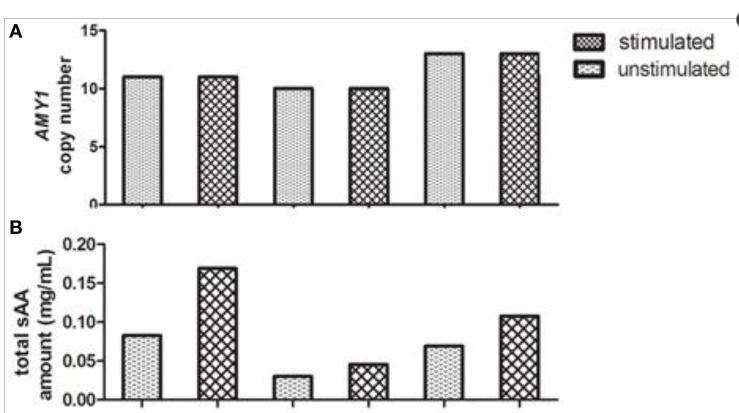
Tip-Before you eat your main meal or any starch – start your meal with some vinegar or acid it increases your salivary amylase: Swish mouth with lemon juice or vinegar or have a salad with an acid dressing on before you start your meal.
Exercise increases salivary amylase for up to 2.5 hours
Exercise increases serum amylase, a high intensity intermittent exercise bout caused a five-fold increase in alpha-amylase activity (P<0.01 compared with pre-exercise) and a three-fold increase in total protein concentration (P<0.01). These returned to pre-exercise values within 2.5 h post-exercise. (Walsh, 1999 ) A recent review indicates that exercise consistently increases mean salivary α-amylase activities and concentrations, particularly at an intensity of >70% VO2max in healthy young individuals (Koibuchi 2015).
Tip: the best time to eat starch is after you have done exercise at a high intensity, eat within 2 hours
Other tips to lower the Glycemic Index (GI) of a meal:
Protein, non starch vegetables and fat slow the digestion of carbohydrates, start your meal with the protein and eat the starch after that.
Eat your non starch vegetables before any starch
One study showed that blood glucose rises were lower if vegetables were eaten before starches, this effect was pronounced for people with type 2 diabetes, (T2D), and even more pronounced for people with normal glucose tolerance (NGT) (Imai,2013 )
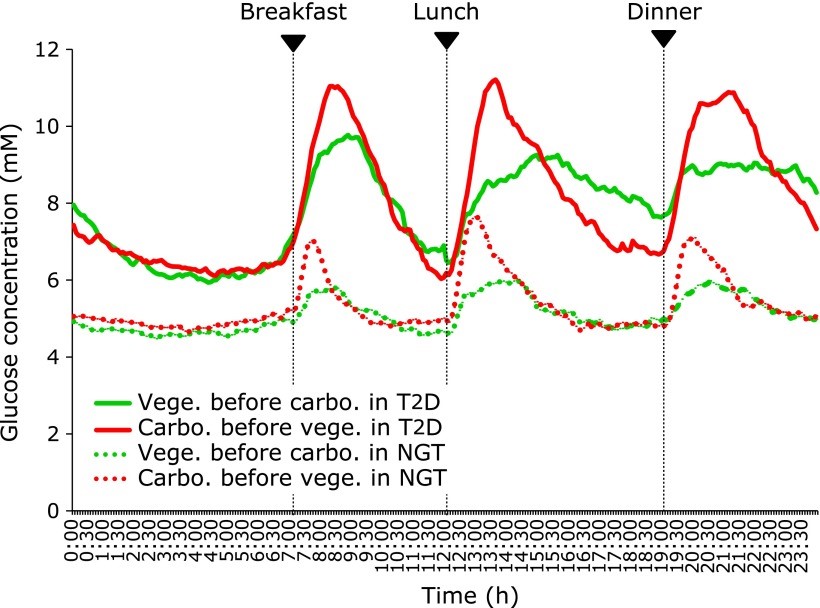
Even better- eat your protein and your non starch vegetables before your starch
In the table below both blood glucose and insulin are substantially reduced when protein and non starch vegetables are eaten before starch foods, compared with the other way round (Shukla, 2015)
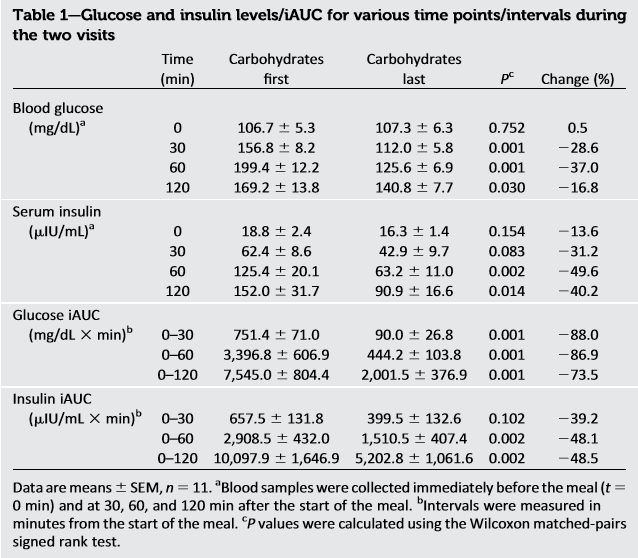
Chew, chew, chew
And lastly, the more you chew your starchy food, the longer it will be in contact with amylase, so take your time when eating starches.
References
Falchi M., El-Sayed Moustafa J.S., Takousis P., Pesce F., Bonnefond A., Andersson-Assarsson J.C., Sudmant P.H., Dorajoo R., Al-Shafai M.N., Bottolo L., et al. (2014) Low copy number of the salivary amylase gene predisposes to obesity. Nat. Genet., 46, 492–497. [PubMed]
Imai S, Fukui M, Kajiyama S. Effect of eating vegetables before carbohydrates on glucose excursions in patients with type 2 diabetes. J Clin Biochem Nutr. 2014 Jan;54(1):7-11. doi: 10.3164/jcbn.13-67. Epub 2013 Dec 27. Review. PMID:24426184 Free PMC Article
Koibuchi E, Suzuki Y. Exercise upregulates salivary amylase in humans (Review). Exp Ther Med. 2014 Apr;7(4):773-777. Epub 2014 Jan 23. PMID:24669232 Free PMC Article
Mandel AL, Peyrot des Gachons C, Plank KL, Alarcon S, Breslin PA. Individual differences in AMY1 gene copy number, salivary α-amylase levels, and the perception of oral starch. PLoS one. 2010 Oct 13;5(10):e13352. doi: 10.1371/journal.pone.0013352.PMID:20967220 Free PMC Article
Mandel AL, Breslin PA. High endogenous salivary amylase activity is associated with improved glycemic homeostasis following starch ingestion in adults.J Nutr. 2012 May;142(5):853-8. doi: 10.3945/jn.111.156984. Epub 2012 Apr 4.PMID:22492122 Free PMC Article
Mejía-Benítez MA, Bonnefond A, Yengo L, Huyvaert M, Dechaume A, Peralta-Romero J, Klünder-Klünder M, García Mena J, El-Sayed Moustafa JS, Falchi M, Cruz M, Froguel P. Beneficial effect of a high number of copies of salivary amylase AMY1 gene on obesity risk in Mexican children. Diabetologia. 2015 Feb;58(2):290-4. doi: 10.1007/s00125-014-3441-3. Epub 2014 Nov 14.
Perry G.H., Dominy N.J., Claw K.G., Lee A.S., Fiegler H., Redon R., Werner J., Villanea F.A., Mountain J.L., Misra R., et al. (2007) Diet and the evolution of human amylase gene copy number variation. Nat. Genet., 39, 1256–1260. [PMC free article] [PubMed]
Usher CL, Handsaker RE, Esko T, Tuke MA, Weedon MN, Hastie AR, Cao H, Moon JE, Kashin S, Fuchsberger C, Metspalu A, Pato CN, Pato MT, McCarthy MI, Boehnke M, Altshuler DM, Frayling TM, Hirschhorn JN, McCarroll SA. Structural forms of the human amylase locus and their relationships to SNPs, haplotypes and obesity. Nat Genet 2015; 47: 921-925 [PMID: 26098870 DOI: 10.1038/ng.3340]
Viljakainen H, Andersson-Assarsson JC, Armenio M, Pekkinen M, Pettersson M, Valta H, Lipsanen-Nyman M, Mäkitie O, Lindstrand A. Low Copy Number of the AMY1 Locus Is Associated with Early-Onset Female Obesity in Finland. PLoS One 2015; 10: e0131883 [PMID: 26132294 DOI: 10.1371/journal.pone.0131883]
Walsh NP, Blannin AK, Clark AM, Cook L, Robson PJ, Gleeson M. The effects of high-intensity intermittent exercise on saliva IgA, total protein and alpha-amylase. J Sports Sci. 1999 Feb;17(2):129-34. PMID: 10069269
Yang ZM, Chen LH, Zhang M, Lin J, Zhang J, Chen WW, Yang XR. Age Differences of Salivary Alpha-Amylase Levels of Basal and Acute Responses to Citric Acid Stimulation Between Chinese Children and Adults.Front Physiol. 2015 Nov 18;6:340. doi: 10.3389/fphys.2015.00340. eCollection 2015.Free PMC Article
